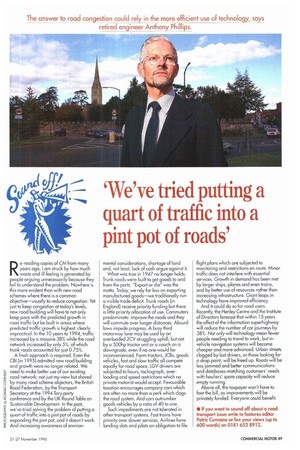'We've tried putting a quart of traffic into a pint pot of roads'
Page 51

If you've noticed an error in this article please click here to report it so we can fix it.
Re-reading copies of CM from many years ago, I am struck by how much waste and ill-feeling is generated by people arguing unnecessarily because they Fail to understand the problem. Nowhere is this more evident than with new road schemes where there is a common objective—usually to reduce congestion. Yet just to keep congestion at today's levels, new road building will have to not only keep pace with the predicted growth in road traffic but be built in areas where predicted traffic growth is highest: clearly impractical. In the 10 years to 1994, traffic increased by a massive 38% while the road network increased by only 5%, of which trunk roads accounted for just 0.75%. A fresh approach is required. Even the CBI (in 1995) admitted new road building and growth were no longer related. We need to make better use of our existing road network: not just my view but shared by many road scheme objectors, the British Road Federation, by the Transport Secretary at the 1994 Tory party conference and by the UK Round Table on Sustainable Development. In the past, we've tried solving the problem of putting a quart of traffic into a pint pot of roads by expanding the pint pot, and it doesn't work. And increasing awareness of environ
mental considerations, shortage of land and, not least, lack of cash argue against it. What was true in 1947 no longer holds. Trunk roads were built to get goods to and From the ports. "Export or die" was the motto. Today, we rely far less on exporting manufactured goods—we traditionally run a visible trade deficit. Trunk roads (in England) receive priority funding but there is little priority allocation of use. Commuters predominate: improve the roads and they will commute over longer distances. Absurd laws impede progress. A busy third motorway lane may be used by an overloaded 2CV struggling uphill, but not by a 500hp tractor unit or a coach on a downgrade, even if no one would be inconvenienced. Farm tractors, JCBs, goods vehicles, fast and slow traffic all compete equally for rood space. IGV drivers are subjected to hours, tachograph, overloading and speed restrictions which no private motorist would accept. Favourable taxation encourages company cars which are often no more than a perk which clogs the road system. And cars outnumber goods vehicles by a ratio of 40 to one. Such impediments are not tolerated in other transport systems. Fast trains have priority over slower services. Airlines have landing slots and pilots an obligation to file flight plans which are subjected to monitoring and restrictions en route. Minor traffic does not interfere with essential services. Growth in demand has been met by larger ships, planes and even trains, and by better use of resources rather than increasing infrastructure. Giant leaps in technology have improved efficiency. And it could do so for road users. Recently, the Henley Centre and the Institute of Directors forecast that within 15 years the effect of the information superhighway will reduce the number of car journeys by 38%. Not only will technology mean fewer people needing to travel to work, but invehicle navigation systems will become cheaper and more advanced. Urban streets clogged by lost drivers, or those looking for a drop point, will be freed up. Roads will be less jammed and better communications and databases matching customers' needs with hauliers' spare capacity will reduce empty running. Above all, the taxpayer won't have to foot the bill, as improvements will be privately funded. Everyone could benefit.




















































































































































































































